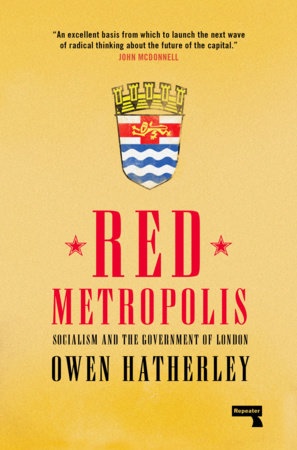This is the last article you can read this month
You can read more article this month
You can read more articles this month
Sorry your limit is up for this month
Reset on:
Please help support the Morning Star by subscribing here
Red Metropolis: Socialism and the Government of London
by Owen Hatherley
(Repeater Books, £10.99)
FOR anyone who’s lived in London during the last 50 years — and especially if you’ve taken an interest in its politics — Owen Hatherley’s book is unputdownable. He knows his stuff and writes so fluently that he’s made what could be a very dry subject into a page-turner.

A book about much more than the title suggests, it’s also an attempt to understand the Labour Party’s crushing December 2019 defeat and suggest some ways for the left to reform, in part inspired by London’s radical tradition.
Hatherley charts the evolution of pan-London governance from the 1889 founding of the London County Council (LCC), through the creation of the Greater London Council (GLC) in 1964 — and its spiteful abolition by Margaret Thatcher in 1986 — to its post-2000 incarnation as the Greater London Authority (GLA) with a directly elected mayor.
Different phases have brought significant shifts in the scope and type of policy intervention, ranging from pioneering council house building under the LCC, the managerialism of Herbert Morrison in the 1930s, the progressive Ken Livingstone years, the PR bluster of Boris Johnson and the inveterate caution of Sadiq Khan.
One of Hatherley’s special qualities is his ability to relate such political changes to an informed and eloquent appreciation of changing architecture, an example being his comparison of the confident “grandiosity and symmetry” of County Hall, the LCC’s original Thames-side HQ, with the “stray testicle” of the current City Hall.
But, refreshingly, the main character in Red Metropolis is housing. As Hatherley points out, it’s the vital issue for London and other cities that politicians frequently ignore. Specifically, he shows how council housing has embodied the character of the city’s working-class communities and remains the key element in any attempt to make London genuinely sustainable and diverse.
Hatherley also draws attention to the ambivalent and, in my view, ill-informed attitude towards council housing among some on the left. He illustrates this through a critical but balanced evaluation of Ken Livingstone’s periods as London mayor, which he suggests has had a significant influence on more recent Labour Party politics.
The radicalism of the GLC in the 1980s, with genuine efforts to develop an egalitarian administration, was not, Hatherley argues, always matched by an appreciation of the true value of council housing. This “blind spot” was even more pronounced during Livingstone’s later mayoral terms from 2000 to 2008 and was sometimes mirrored by the forces that propelled Corbynism.
No book is perfect and Hatherley’s flowing, caustic style can occasionally seem glib and his polemic sometimes needs more evidence. There is also an underlying pessimism that suggests unawareness of some important grassroots campaigns, particularly around housing.
The largely successful rebellion against the 2015-16 Housing and Planning Act and its “Pay to Stay” policy that posed a mortal threat to London council housing, goes unmentioned, as do the several local defeats by tenants of New Labour’s attempts to privatise council housing through stock transfer.
While skewering the absurdity of their past policies, Hatherley is perhaps beguiled by the current housing policies of some London Labour councils such as local housing companies, which have already begun to fail.
He also approvingly cites Preston City Council’s alternative approach and, while such local economic strategies may have some merit, like their 1980s counterparts they don’t fundamentally challenge the status quo. As Hatherley demonstrates, they prove short-lived — there are no “shortcuts out of neoliberalism,” as he himself declares.
As a very readable and enjoyable history, Red Metropolis offers some important arguments about the future. While some of Hatherley’s proposals might appear excessively focused on London and the Labour Party, he quite rightly identifies Labour’s 2019 housing manifesto as a good starting point for rebuilding confidence in the left — and the failure to properly campaign around it as a factor in the 2019 general election defeat.
More generally, he advocates that the left should draw on its own past, with London proving that bold socialist policies can have wide popular appeal, even in seemingly unpromising places.
The issues in Red Metropolis will assume even greater pertinence in 2021. In the shadow of Covid, London is due to elect its next mayor in May and, while Khan may be favourite, his constant prevarication and pandering to corporate interests could undermine the Labour Party’s dominance in the city.
We are entering a critical period, with a rabid government intent on making workers pay for the pandemic with our livelihoods and lives. The recent gun-to-the-head handling of Transport for London’s finances is a warning.
Instead of retreating, Khan should harness the growing anger and desperation of Londoners to build a fightback in the best tradition of his predecessors, with real council housing, investment in public services and anti-racism at its core.
He, at least, should read Hatherley’s book.











